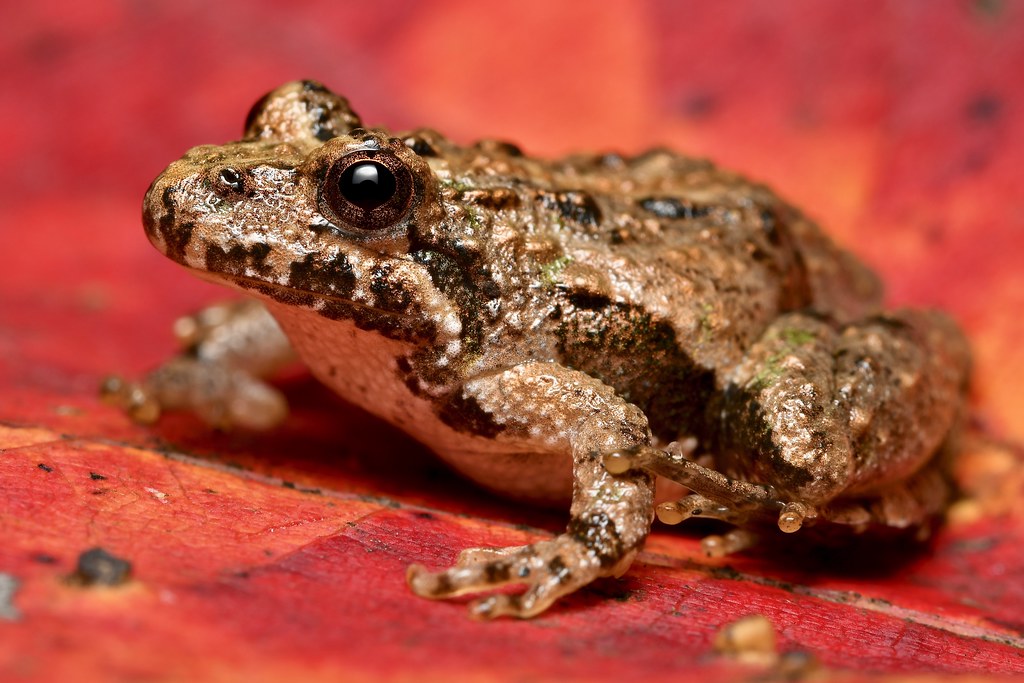#northern cricket frog
Text

today's funky frog of the day: the northern cricket frog (Acris crepitans)!!!!!! these charming amphibians have two subspecies. they live in the united states and mexico, and are diurnal, which means they're active during the day! the green on this fellow is so striking!
photo © Judy Gallagher
#northern cricket frog#Acris crepitans#hey. i'm so sorry for the .#very unplanned lack of activity#i had a life event that i didn't realize the gravity of / negative impact on#myself until months later#and by that time i had stopped doing so many things bc it was all too much#but i think i'm in a better space now#and funkyfrogoftheday is smth that brings me joy#and as i get back to my sense of self i think this is a good thing to do#so uhh welcome back. frog time!#this ones so cute#funky frog of the day#frog#frogblr
534 notes
·
View notes
Text
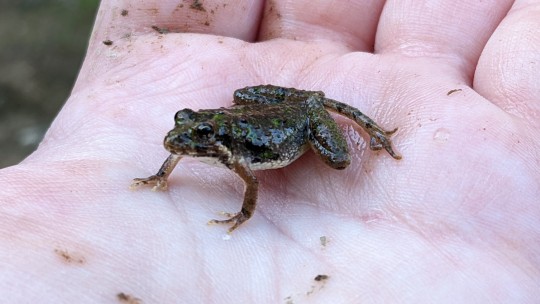

Just a cute little Northern Cricket Frog (Acris crepitans)
4 notes
·
View notes
Text

Northern Cricket Frog (Acris crepitans), family Hylidae, found in the eastern 2/3 of the United States and NE Mexico
These small frogs only reach a maximum length of 3.8 cm (1.5 in).
photograph by Anthony Brais
377 notes
·
View notes
Text
Day 12 is eat so I decided that it was the perfect time to talk about how weird frog eating is. Before anything let’s meet our model for today, Leo the Northern Leopard Frog (Lithobates pipiens).

Now Leo, like many leopard frogs, eats flies, crickets, worms, and indulges in a little cannibalism. But let’s ask, how does he eat them? He uses his tongue!

Now that’s not right, one moment
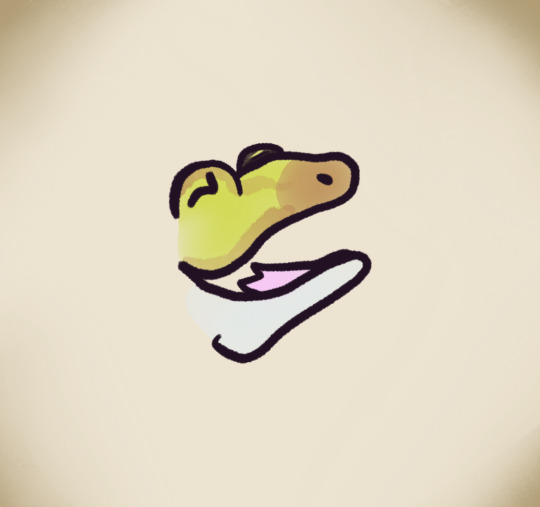
There we go! Frog tongues are attached to the inner lower “lip”, so to shoot out their tongue they just flip it out.

But wait, how does their prey stick to their tongue? While they’re many factors like the softness of it (being the softest biological material ever seen) and the damping (similar to that of a car’s shock absorption) what I find the most interesting is the saliva! Their saliva is non Newtonian, becoming thin when shear force is applied then thickening soon after. In this way when the frog shoots its prey it’s saliva covers it before thickening trapping the prey inside.
Congrats! The prey is now in Leo’s mouth, but now what? While Leo’s backwards tongue is great at catching food it’s less great for swallowing it.

Wait Leo how did you do that? Oh I see they used their eyes!

Yep, in lieu of a tongue many frog species use their eye stalks to push food down their throat! What clever creatures they are. Thank you Leo for your time.

If you want to learn more about how a frog’s tongue works check out this paper by Alexis C. Noel, Hao-Yuan Guo, Mark Mandica and David L. Hu.
And this paper to learn more about how frogs swallow with their eyes by Robert P. Levine, Jenna A. Monroy, and Elizabeth L. Brainerd.
161 notes
·
View notes
Photo

Northern Cricket Frog
71 notes
·
View notes
Note
assign an insect to each of your OCs!
Third time trying to answer this because Tumblr won't stop freezing! Anyway here we go...
Akani: Frog-legged Leaf Beetle

Kiomi: Bumble Bee

Ruhara: Hickory Tussock Caterpillar

Arline Lanes: Brown Mantidfly
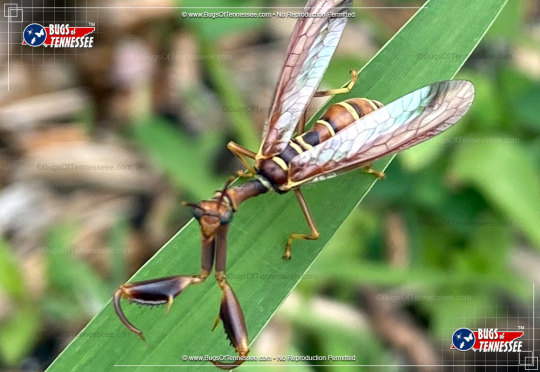
Fox: Baltimore Checkerspot
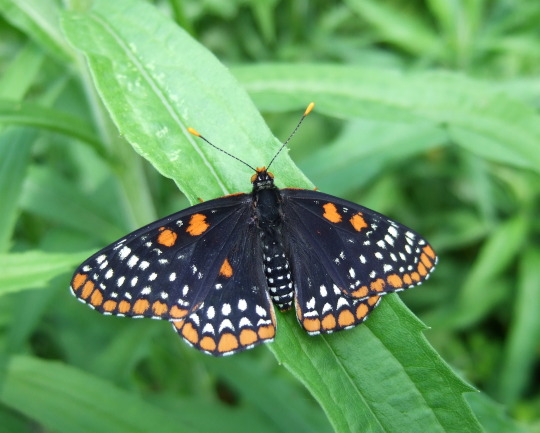
Beatrice Maddison: Black and Red Blister Beetle

Dannie Karim: Northern Walkingstick

Stick bugs!!
Ryn Halvorsen: Eastern-tailed Blue Butterfly
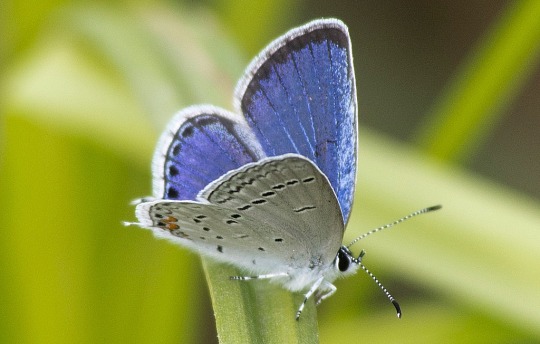
Silas Petersson: Bumelia Borer Beetle
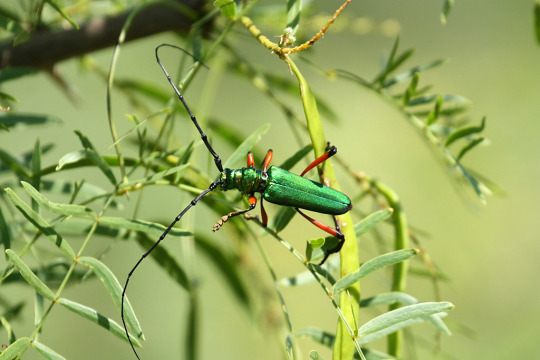
Pigeon: Pigeon Tremex
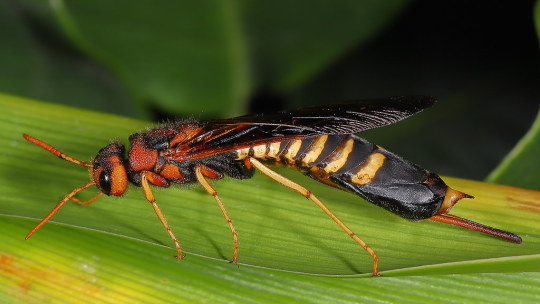
Arith: Two-spotted Forester Moth
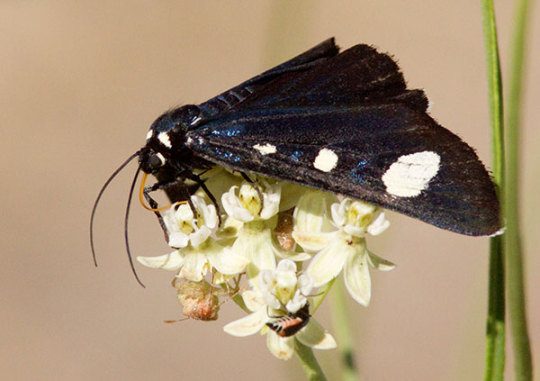
Iriel: Gold Moth

Kaia: White-striped Black Moth
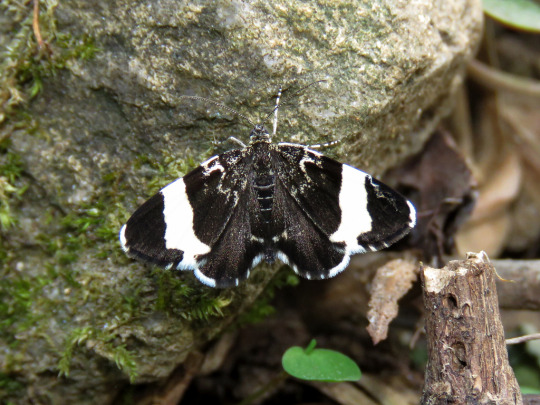
Odel: Volupial Mint Moth

Eliška Hasek: Fire-colored Beetle

Marigold Rosales: Golden Northern Bumble Bee

Rosie Rosales-Maximoff: Rose Hooktip Moth
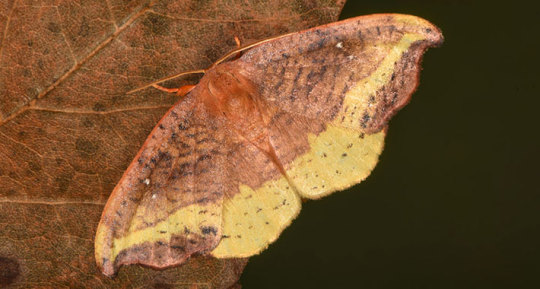
Allison Dahir: Soft-winged Flower Beetle

Lee Quinn: Big Poplar Sphinx

Jelaa Latka: Australian Tiger Beetle

Van Kahl: Giant Thorny Cricket because I love their goofy little faces

#answered asks#pringle answers#practically an xman#insects#bugs#bugs tw#insect tw#fursonas#akani#kiomi#ruhara#arline the arcane oc#arline lanes#oc: fox#carina shepherd // beatrice maddison#dannie karim#ryn halvorsen#silas petersson#nameless ghoul pigeon#pringles good omens ocs#eliška hasek#xmen oc au#lee quinn#jelaa latka#van kahl
7 notes
·
View notes
Text

Bestiary of Thedas
From bird to insect, fish to land animal. Every creature mentioned in Dragon Age, blighted and non-blighted, spirits and demon, created and possessed creatures alike are listed along with their breeds, subspecies, or variations.
If you want a more specific list, check out the post for Real World Animals in Thedas
Updated: 2023/11
Amphibian
Frog
Salamander
Toad
Horned Toad
Poison Toad
Birds
Albatross
Black-capped Songbird
Bluebird
Budgerigar
Bunting
Buzzard
Canary
Crow
Dove
Duck
Mallard Duck
Eagle
Falcon
Finch
Goose
Grouse
Gull
Hawk
Kingfisher
Lark
Magpie
Merlin
Mockingbird
Nightingale
Owl
Parakeet
Parrot
Partridge
Peafowl
Pheasant
Pigeon
Ptarmigan
Quail
Raven
Robin
Rock Darter - Native to the Anderfels, an insect eating bird.
Seagull
Simir - A bird hunted in Tevinter for the magical properties in their feathers.
Sparrow
Swan
Swift
Turkey
Vulture
Bald-necked Vulture
Fish and Marine Creatures
Blind Tetrava
Bluefin
Carp
Cetus
Cod
Eel
Lamprey Eel
Jellyfish
Krone
Mackerel
Octopus
Raytooth
River Herring
Shark
Squid
Giant Squid
Trout
Whale
Bony Whale-Shark
Pilot Whale
Whitebait
Crustaceans and Shellfish
Clam
Crab
Giant Swamp Crab
Crayfish
Cuttlefish
Lobster
Mussel
Oyster
Prawns
Shrimp
Insects
Bee
Bumblebee
Honeybee
Beetle
Cave Beetle
Death Watch Beetle
Dung Beetle
Glow Worm
Roof Beetle
Wood-burrowing Beetle
Butterfly
Cricket
Dragonfly
Firefly
Flea
Fly
Blue Flies
Giant Spider
Giant Poisonous Spider
Giant Spiderling
Poison Spider
Gnat
Hornet
Ladybug
Leeches
Locust
Maggot
Scorpion
Silkworms
Slugs
Snail
Spider
Wasp
Worm
Earthworm
Poison Worm
Tapeworm
Mammals
Badger
Honey Badger
Bat
Giant Bats
Bear
Black Bear
Brown Bear
Cavern Bear
Great Bear
Large Bear
Boar
Bogfisher
Bronto
Cat
Cattle
Bull
Cow
Ox
Qalab
Chicken
Cockerel
Cretahl
Dathrasi
Deer
Red Deer
Stag
Dog
Coursing Hound
Ferelden Shepard
Hunting Dog
Mabari
Pug
Rat Terrier
Sheepdog
Wild Dog
Wofun Hound
Donkey
Druffalo
Elephant
Elk
Ermine
Fennec
Ferret
Fox
Gazelle
Ghast
Giant
Goat
Ayesleigh gulabi goats
Mountain Goat
Griffon
Gurn
Halla
Hamster
Hare
Hart
Bercilian Sure-Foot
Greater Frostback Elk
Pride of Arlathan
Red Hart
Royal Sixteen
Tirashan Swiftwind
White Hart
Wild Hart
Horse
Amaranthine Charger
Anderfel
Anderfel Courser
Asaarash
Avvar Mixed Draft
Dalish All-Bred
Fereldan Forder
Free Marches Ranger
Frostback Mountain Horse
Green Dales Feral
Imperial Warmblood
Inquisition Barded Charger
Oath-Bound Steed
Orlesian Courser
Taslin Strider
Hyena
Jackal
Jackrabbit
Lion
Great Lion
Red Lion
Lynx
Marmot
Marten
Mole
Monkey
Moose
Mountain Lion
Mouse
Chip Mouse
Mule
Nug
Nuggalope
Avvar War Nug
Battle Nug
Greater Nuggalope
Greater Mountain Nuggalope
Gwaren Land-Hammer
Knuckled Thunderer
Tiddles Majoris
Otter
Pig
Rabbit
Raccoon
Ram
August Ram
Rat
Giant Rat
Sheep
Snoufleur
Spotted Cat
Spotted Hunting Cat
Squirrel
Tiger
Tusket
Voles
Weasel
Wolf
Black Wolf
Crag Wolf
Great Wolf
Wolverine
Reptiles
Adder
Death Adder
Basilisks
Cobra
Crocodile
Deepstalker
Deepstalker Matriarch - largest deepstalker
Deepstalker Leader - always male, second largest deepstalker
Deepstalker Runner
Dracolisk
Abyssal Hang-Tooth
Basking Longma
Blue River Bane
Desert Lightning
Hunter Shade Dracolisk
Mountain Dracolisk
Primal-Trained Longma
Sharp-Tail
Dragon
Abyssal High Dragon
Fereldan Frostback
Gamordan
Stormrider
Greater Minstral
Guardian of Mythal
Highland Ravager
Hivernal
Hunterhorn Shrikes
Kaltenzahn
Northern Hunter
Sandy Howler
Stonejaw
Vinsomer
Dragonling
Drake
Great Dragon
Guardian Serpent
Gurgut
Lurker
Phoenix
Quillback
Sand Stalker - a small vermin-like creature similar to deepstalkers
Sand Stalker Spitter
Sand Stalker Leader - larger than common sand stalkers
Varghest
Viper
Wyvern
Snowy Wyvern
Created Creatures
Golem
Varterral
Blighted Creatures
Bereskarn
Blight Owl
Blight Wolf
Blighted Werewolf
Bloodcrow
Corrupted Spider
Corrupted Spider Queen
Darkspawn
Archdemon
Broodmothers
Children
Emissary
Genlock
Hurlock
Ogre
Shriek
Darkspawn Magisters (Named and known)
The Architect
Corypheus
Dragon Thrall
Ghoul
Created Creatures
Golem
Varterral
Demons and Spirits
Spirits
Choice
Command
Compassion
Faith
Hope
Justice
Knowledge
Perseverance
Valor
Wisdom
Memory
Wisp
Wraith
Demons
Desire
Despair
Envy
Fear
Hunger
Pride
Rage
Remorse
Shade
Sloth
Terror
Vengeance
Possessed/Magical Creatures
Abomination
Arcane Horror
Ash Wraith
Corpse
Devouring Corpse
Devouring Skeleton
Enraged Corpse
Fanged Skeleton
Shambling Corpse
Shambling Skeleton
Skeleton
Skeleton Archer
Skeleton Mage
Walking Corpse
Dryads
Harvester
Revenant
Rock Wraith
Ancient Rock Wraith
Sylvans
Vampire
Werewolf
Wood Nymphs
Undefined
Glowing Slime
Firesprite
Wandering Hills
Sources
Dragon Age Origins + DLCs
Dragon Age Awakening
Dragon Age 2 + DLC
Dragon Age Inquisition + DLC
Dragon Age Inquisition Multiplayer
Dragon Age: Last Court
Dragon Age: Official Cookbook: Tastes of Thedas
Dragon Age Tabletop Core Rulebook
Dragon Age Tabletop Blood of Ferelden
World of Thedas Vol 1
World of Thedas Vol 2
Dragon Age: Asunder
Dragon Age: Masked Empire
Dragon Age: Last Flight
Dragon Age: Tevinter Nights
Short Story: The Riddle of Truth
Short Story: Varric
Dragon Age Origins
Armor: Clamshell Armor
Armor: Dalish Gloves
Codex: The Bow of the Golden Sun
Codex: Bronto
Codex: Deepstalker
Codex: The Frostback Mountains
Codex: Meditations and Odes to Bees
Codex: Nug
Codex: Rat
Codex: The Vaterral
Item: Fox's Pendant
Item: Golden Mirror
Item: Lamb Bone
Item: Micah/s Lucky Deer Foot
Item: Ox Bone
Item: Rat Poison
Item: Uncrushable Pigeon
Weapon: Cat Lady's Hobble-Stick
Dragon Age 2
Armor: Rat-Nibbled Gloves
Codex: Broken Dowsing Rods - No Refunds
Codex: Carta Bronto
Codex: Pride and Rider
Junk: Stuffed Parrot
Quest: Redblossom Special
Weapon: The Tiger's Tail
Last Court
The Acerbic Dowager
The Applewoods
The Arrival of the Divine
The Boastful Neighbor
The Cheery Baron
Choose your quarry
The Dowager Steps Forward
Enlightenment
Glass
Glassblowers' Anger
Graffiti
A Life of Toil
A Meeting with the Outlaw
A Plea for Sanctuary
River Herring
The Sealed Chantry
A Swift Stream
Sylvian Raid
An Unofficial Meeting
The Well-Read Pig-Farmer
You have cornered the bear
You have the hind in view
Dragon Age Inquisition Items and Codex
Codex: August Ram
Codex: Andruil's Messenger
Codex: Bear (Inquisition)
Codex: Constellation Tenebrium
Codex: Correspondence Interruptus
Codex: Crate of the Live Death Watch Beetles
Codex: Cretahl
Codex: Dirthamen: Keeper of Secrets
Codex: The Folly of General Not-Shertan
Codex: Ghilan'nain: Mother of the Halla
Codex: Hard in Hightown Chapter 15
Codex: A Horsemaster's Notes on Mounts
Codex: The Hunt of the Fell Wolf
Codex: Journal of Gurd Harofsen
Codex: The Lion of Orlais
Codex: Moldy Journal
Codex: A Nutty Affair
Codex: On Avvar Cuisine
Codex: The Perendale War
Codex: Ram
Codex: Scout Lace Harding
Codex: Surviving the Western Approach
Landmark: Crestwood: The Guide of Falon'Din
Note: Charred Note
Note: Sera's Cabinet of Wonder Whose it Was
Valuable: Carved Cricket Charm
Valuable: Cut Crystal Lion
Valuable: Eagle Feather Charm
Valuable: Falcon Crest
Valuable: Glass Fox
Valuable: Golden Ladybug Charm
Valuable: Grouse Feather Charm
Valuable: Raven Totem
Valuable: Silver Dragonfly Charm
Valuable: Vulture Feather Charm
Valuable: Wooden Mabari Figurine
Wartable Mission: A Present for Bianca
Wartable Mission: Smash
Want to support this blog? Check out my ko-fi?
#dragon age#fauns of thedas#da ttrpg#lore reference#writing reference#da writing reference#da worldbuilding#dragon age reference#fauna fridays#long post#creature: birds#creature: insect#creature: spider#creature: fish#creature: horse#creature: dragon#creature: hart#creature: nug
35 notes
·
View notes
Text

Red-eyed tree frog at La Paz Waterfall, Costa Rica
Stephanie LeBlanc
Scientific name: Agalychnis callidryas
Conservation status: Least Concern (Population decreasing)
Lifespan in captivity: about 8-12 years
Class: Amphibia
Domain: Eukaryota
Family: Hylidae
Genus: Agalychnis
Habitat: Lowland tropical rainforests with high humidity and warm daytime and nighttime temperatures, often near a river or water source.
Range: Found in tropical lowlands from southern Mexico, throughout Central America, and in northern South America
Diet: Carnivores. This nocturnal carnivore feeds primarily at night on insects, including: grasshoppers, flies, moths and crickets. The Red-Eyed Tree Frog eats anything it can fit in its mouth, even smaller frogs.
Lifespan: About 5 year in the wild and 8-12 years under human care
#La Paz Waterfall#Costa Rica#South America#Red-eyed tree frog#red eyed tree frog#Frog#Frogs#Wildlife#CostaRicaWildlife
3 notes
·
View notes
Text
Final recap: what a trip!
That's it; after 23,418 kilometers driving across the country, I arrived back home at my dear friends Arpita & Navneet on Sunday 17th September. 🥰 Having left on 1st June, I was on the road for 15.5 weeks, and I'm honestly amazed at how easy it went and how normal it felt! 😊 Apart from the occasional bugs, wasps, snakes 😆 & thunderstorms, I loved every second and made memories that I will cherish forever.


I'm not going to say that this was a trip of a lifetime, as I might do more similar road trips in the future (it has been a longterm bucket list of mine to drive from Ushuaia in South Argentina to the Chilean border with Peru, a mere 6,000 kms 😄) but it was very very special... it was unique to spend so much time discovering the diversity of all that Canada has to offer, nature & people wise, and it felt like one long farewell party! 🤩 I'm proudly Canadian and am very grateful having gotten to know this country more intimately!
I'm not going to repeat all the things I've done, the best experiences etc but just wanted to share the stats that I collected during the trip. I loved writing these posts and hope you enjoyed reading them! 😍
hug, Fleur 💖
SUPs: 19
Hikes: 86
Icebergs: 47
Wildlife:
140 bison
1 grizzly bear with 2 cubs and 4 black bears
4 moose, 39 deer, 1 elk and 5 pronghorn antilopes
21 bighorn sheep
1 fox and 2 coyotes
8 snakes, 2 turtles, tens of tiny frogs and 1 salamander
1000s of grasshoppers & crickets
115 ground squirrels (gophers) and 100 prairie dogs
3 rabbits, 1 marmot and 2 porcupines
148 harbour seals and 7 gray seals
12 humpback whales, 3 mink whales, 7 belugas and 11 harbour porpoises
5 beavers, 1 otter and 1 muskrat
12 bald eagles and 2 golden eagles
2 great grey owls
2 ferruginous hawks, 4 red-tailed hawks, 1 osprey and 1 falcon
8 turkeys and 17 partridges
51 sandhill cranes, 10 blue great herons and 1 green heron
50 puffins
102 Eider ducks, 52 Merganser ducks and 9 loons
thousands of northern gannets, razorbills & other sea birds, 2 sand pipers, and lots of terns
10,000 mosquitos
PS. I did not see a single raccoon during the entire trip!

2 notes
·
View notes
Text
My part of a trade for @mouseship! Reminder that trades/commissions are open!
The moonlight shone down gently onto the island. The leaves of the palm trees shone with silvery lines as they danced in the delicate wind. Frogs and crickets could be heard chirping and buzzing, singing their symphony of the night. Few remained out at this hour, as the sun had long since set. However, a certain mouse and koala were sitting on one of the cliffs, looking up into the sky.
“Ooo! There’s Libra! Its diamond shape gives it the appearance of a pulled bow.” Grae explained.
The two islanders had settled for a night of star-gazing, a common activity among couples. However, it was made even more enjoyable as Grae had studied up on different constellations as part of his job, and knew quite a lot about them.
“And look! There’s sagittarius right across from it! It's one of the more complex constellations, who knows how they got a centaur out of that.” The mouse giggled.
Eugene had never been one for memorizing stars, but he couldn’t help but be entranced as Grae described the constellations. He found himself gaining a new respect for the stars, looking up at them in wonder alongside his partner. But most importantly, he got to hear him talk about something he was passionate about. Not only did he admire his extensive knowledge on the subject, he loved the way he lit up as he spoke, getting lost in his own world. He felt like he could hear him ramble on forever…
“Eugene?” Grae asked.
“Hm?” The koala snapped out of his trance. “Oh, sorry, did you say something?”
He rolled his eyes playfully. “I asked what your favorite constellation is.”
Eugene thought for a moment. “Well… I don’t know, what’s your favorite?”
Grae tilted his head, thinking for a moment. “I guess I’d say Ursa Major. Its one of the most well known constellations in the Northern Hemisphere, and its shape mimics the little dipper!”
“Heh, who would’ve thought a little guy like you would love such a big constellation.” Eugene teased.
He retorted with a nudge. “Hey now, you still haven’t told me what your favorite is.”
Now it was Eugene’s turn to think. He looked to the sky again, deep in thought.
“Maybe… Scorpius? I mean, I know I may be cheating because I’m a scorpio, but I always thought it looked cool.”
Grae perked up at this. “You know what? Scorpius is visible during this time of year! Look!”
He pointed upwards, the stars reflecting in his wide pupils. “Right between Libra and Sagittarius. Did you know that its called Scorpius because the long part resembles a scorpion’s stinger?”
Looking up at it, Eugene saw the “tail” that Grae traced with his fingers. He felt a sense of wonder as he looked, taking in the moment as the stars stared back at them.
“You know,” He spoke after a moment, “As beautiful as all these stars are, they pale in comparison to you, babe.”
A bright blush came upon Grae’s face. “... You mean that?”
“Of course. I don’t know anyone else on the island who knows as much about nature and stuff as you do- Well, except Blathers, maybe.” He chuckled.
“Fair enough, he’s the one who helped me learn after all. It was his guidance that helped me learn all I have.”
“Well, he was smart in his choice of apprentices. He picked the smartest mouse on the island.”
“You’re not just saying that?” He hid into a shrug.
A tone of sincerity came over Eugene’s voice. “Of course, babe. I mean it when I say I am beyond amazed by your smarts. And you’re funny, kind, and just overall amazing to boot. Who wouldn’t want you around?”
“That means a lot to me. Thanks, love.”
Eugene responded with a hug, cherishing the feeling of having his love so close to him. “Anytime.”
After a moment, the two let go. But the koala let Grae rest his head on his shoulder, still looking to the sky. That night, it felt like just them and the stars, and Eugene wouldn’t have it any other way.
2 notes
·
View notes
Video
Northern Cricket Frog by Melville Osborne
#flickr#frog#norther cricket frog#new jersey#nature#animals#Photography#Autumn#Autumn Aesthetic#Autumncore#Fall Aesthetic#Autumn Cozy#Fall Blog
2 notes
·
View notes
Text
Tuning into Nature: The Interplay of Music and the Natural World 🎶
When I lace up my hiking boots and venture into the wilderness, there's one companion I always make sure to bring along: music. To me, music and nature are inseparable companions on my journeys, each complementing the other in a beautiful dance of harmony. But where exactly does one find music in nature, and where does nature find its way into music?
Let's start with the first question: where is music in nature? Well, for me, music is everywhere in nature if you listen closely enough. It's in the gentle rustle of leaves in the wind, the rhythmic patter of raindrops on leaves, and the melodic chirping of birds at dawn. And for Gray et al. (2001), it's in the sounds of whales in the ocean and the countersinging of bird species such as the Socorro mockingbird. Nature has its own symphony, a harmonious blend of sounds that ebb and flow with the changing seasons. And now, let's experience a snippet of this symphony firsthand with a video I captured last April:
Immerse yourself in the serene melodies of nature at Starkey Hill Conservation Area in Puslinch, ON. 🌿🎶 Let this video transport you to a place where the beauty of the natural world takes center stage.
Conversely, where is nature in music? Nature's influence on music is undeniable. Many composers throughout history have drawn inspiration from the world around them, infusing their compositions with the sights and sounds of nature (Cooney, 2020). From Vivaldi's "Four Seasons" to Smetana's "The Moldau," nature's influence is woven into the fabric of classical music (Cooney, 2020). But it's not just classical composers who are inspired by nature; artists across all genres have been known to incorporate natural imagery and sounds into their music. Consider, for instance, Zach Bryan's "Smaller Acts," where croaking frogs and distant crickets blend seamlessly with the acoustic strumming of a guitar:
youtube
Direct video link: https://youtu.be/dM_aZOAeLso?si=XLqrweq4O2-lwyhd :)
But nature's influence on music goes beyond mere inspiration—it has been used to actually create music itself. For thousands of years, humans have utilized natural elements to craft instruments and compositions. One fascinating example is the discovery of prehistoric flutes made of animal bone in France and Slovenia, some dating back as far as 53,000 years ago (Gray et al., 2001). These ancient instruments provide tangible evidence of our ancestors' deep connection to the natural world and their desire to capture its essence through music.
Now, let's talk about those songs that transport us back to a natural landscape in an instant. For me, one such song is "Vagabond" by Caamp. The folksy acoustic guitar paired with the raw, emotive vocals instantly evoke memories of long hikes through the rugged terrain of Northern Ontario. There's something about the lyrics and the melody that perfectly captures the sense of adventure and freedom that comes with exploring the great outdoors.
youtube
Direct video link: https://youtu.be/XK3l7QtYeMA?si=WljC1ht2mmHRa9wt :)
Similarly, several songs by Mt Joy have the same effect on me. Whether it's the hauntingly beautiful "Silver Lining" or the anthemic "Sheep," their music has a way of whisking me away to the tranquil beauty of nature. It's as if each note is a brushstroke painting a vivid picture of rolling hills, towering pines, and crystal-clear lakes.
As for the context, well, I often find myself playing these songs on those long hikes in Northern Ontario that I mentioned earlier. There's something truly magical about being surrounded by nothing but wilderness, with only the sound of your footsteps and the occasional rustle of leaves to keep you company. And when you add the perfect soundtrack to the mix, it's like stepping into a scene from a movie – everything just falls into place, and you feel completely at peace with the world.
Overall, the relationship between music and nature is a deeply profound and endlessly fascinating one. Whether it's finding music in the sounds of nature or discovering nature within music, there's something inherently beautiful about the way these two elements intertwine. This interconnectedness resonates deeply with our ongoing dialogue on Indigenous value systems, which reject the notion of a strict division between culture and nature (Hooykaas, 2024). So the next time you find yourself out in the wilderness, take a moment to listen – you just might hear the sweet melodies of nature's symphony all around you🌷. Until next time!
Madison B.
References:
Cooney, D. (2020, May 15). Inspiration: An NSO Young People’s Concert about Big Ideas and Big Music. The Kennedy Center. https://www.kennedy-center.org/education/resources-for-educators/classroom-resources/media-and-interactives/media/music/ypc/inspiration/
Gray, P. M., Krause, B., Atema, J., Payne, R., Krumhansl, C., & Baptista, L. (2001). The Music of Nature and the Nature of Music. Science, 291(5501), 52-54. https://link-gale-com.subzero.lib.uoguelph.ca/apps/doc/A69270354/AONE?u=guel77241&sid=bookmark-AONE&xid=fb9366a8
Hooykaas, A. (2024). ENVS*3000 Nature Interpretation course notes. Retrieved February 27, 2024, from https://courselink.uoguelph.ca/d2l/le/content/858004/viewContent/3640021/View
0 notes
Text
Japan's Fauna:
Despite the country's enormous human population, Japan's land animals are quite abundant in the distant, densely wooded mountain areas. These creatures include bears, wild boars, raccoon dogs (tanuki), foxes, deer (including sikas), antelope, hares, and weasels; some species are unique from those found on the nearby Asian continent. Wild monkeys (the Japanese macaque) live in a variety of habitats, with those found on the northern point of Honshu being the world's northernmost monkey habitation.

youtube
Reptiles consist of sea turtles, freshwater tortoises, sea snakes, and lizards. There are two dangerous snake species, but the majority of snakes, including the 5-foot (1.5-meter) long Japanese rat snake, are innocuous. Toads, frogs, and newts are widespread, while the endemic Japanese giant salamander of Kyushu and western Honshu can grow to be four feet long or more. Insect life is typical of a temperate humid environment; some species have seasonal connotations in literature and popular culture, such as cicadas and dragonflies (summer) and crickets (fall). The Japanese archipelago is a significant East Asian flyway, and around 600 bird species are either resident or migratory. Water birds abound, including gulls, auks, grebes, albatrosses, shearwaters, herons, ducks, geese, swans, and cranes. Cormorants are occasionally trained to capture fish. There are around 150 different types of songbirds, as well as eagles, hawks, falcons, pheasants, ptarmigan, quail, owls, and woodpeckers.

youtube
The convergence of cold and warm ocean currents around Japan has resulted in a thriving marine life. Whales, dolphins, porpoises, and a variety of fish including salmon, sardines, sea bream, mackerel, tuna, trout, herring, grey mullet, smelts, and cod live in Japanese seas. Crustaceans and mollusks include crabs, prawns, clams and oysters. The rivers and lakes are rich in trout, salmon, and crayfish. Carp (koi) are frequently kept in ponds, both for commercial food production and ornamental purposes.
Havard reference:
The Editors of Encyclopaedia Britannica. (1998). Japan fauna. [Online]. britannica. Last Updated: 27 October 2023. Available at: https://www.britannica.com/place/Japan/Soils [Accessed 21 February 2024].
0 notes
Text
Glass frog dump cause of the reason ⭐🌟I CAN :0⭐🌟
The glass frog can jump more than ten feet in one jump. The male frog guards the females' fertilized eggs placed on leaves until they hatch and the tadpoles fall into the water. The translucent skin of some species permits an observer to see the frog's beating heart. Glass frogs live up to 14 years.
Habitat
The glass frog is found in humid montane forests throughout Central and South America including Belize, Costa Rica, Colombia, Guatemala, Honduras, Mexico and Panama.
Predators
One of the most dangerous natural predators to the reticulated glass frog is the wasp. As tadpoles, the frogs are in an extremely vulnerable position and can be carried away by wasps or other flying insects for food. Snakes, birds, and some smaller mammals will target the reticulated glass frog as well.
Diet
Insects
Diet. Similar to its red-eye leaf frog friend, the reticulated glass frog is a carnivore. Their diet is mainly small insects like crickets, moths, flies, spiders, and even other smaller frogs.
Size
to one and a half inches
The northern glass frog, or Fleischmann's glass frog, is a small tree frog that averages between three-quarters of an inch to one and a half inches (20 – 32 mm) in length. The name “glass frog” is derived from the white, translucent skin on its belly, where the frog's beating heart and other organs are visible
Glass frog types
· Hyalinobatrachium valerioi
· Hyalinobatrachium fleischmanni
· Espadarana prosoblepon
· Sachatamia albomaculata
· Hyalinobatrachium colymbiphyllum
· Hyalinobatrachium nouns
· Nymphargus grandisonae
· Sachatamia ilex
· Cochranella granulosa
· Powdered glass frog
· Hyalinobatrachium dianae
· Tukeit Hill frog
· "Cochranella" geijskesi
· Urrao Cochran frog
· Nymphargus ocellatus
· Hyalinobatrachium aureoguttatum
· Hyalinobatrachium yaku
· Hyalinobatrachium iaspidiense
· Centrolene ballux
· Hyalinobatrachium ruedai
· Centrolene prosoblepon
· Nymphargus mariae
· Nymphargus mariae
· Hyalinobatrachium orientale
· Nymphargus manduriacu
· Sachatamia orejuela
· Hyalinobatrachium chirripoi
· Teratohyla spinosa
· Vitreorana uranoscopa
· Nymphargus balionota
· Centrolene lynchi
· Centrolene pipilata
· Hyalinobatrachium vireovittatum
· Nymphargus cochranae
· Hyalinobatrachium talamancae
· Centrolene antioquiensis
· Centrolene gemmatum
· Nymphargus bejaranoi
· Centrolene daidalea
· Centrolene bacatum
· Vitreorana gorzulae
· Nymphargus cariticommatus
· Nymphargus griffithsi
· Nymphargus luminosus
· Cochranella nola
· Sachatamia punctulata
· Nymphargus ruizi
· Rulyrana spiculata
· Nymphargus truebae
· Hyalinobatrachium bergeri
· Hyalinobatrachium guairare
What is the largest glass frog species?
It is commonly known as either the Ghost Glass Frog or the Limon Giant Glass Frog. Sachatamia ilex can be up to twice the size of related species, making it the largest species of glass frog in Central America. This frog also has prominent, protuberant nostrils located on a slightly elevated ridge on its head.
What are some problems with glass frogs?
Endemic to Latin America, glass frogs are threatened by widespread habitat loss, climate change, chytrid fungus and significant pressure from the international pet trade.
Body
Glass frogs are usually tiny and can fit in the palm of the hand. The bodies are lime green on the top and transparent when viewed from underneath, revealing all their internal organs. They may also be white with a reticulated pattern of yellow spots that mimic the appearance of eggs within the female.
Fleischmann's Glass Frog
Fleischmann's Glass Frog, also known as the Northern Glass Frog, is a small, delicate frog, 2-3.2 cm in length, with light green skin with yellow spots and fine black flecks. It has a short, rounded snout and gold irises with horizontal, elliptical pupils, and its eyes point forward.
1 note
·
View note
Text
TOP 5 FAMOUS FOOD IN PAMPANGA
MORCON KAPAMPANGAN

The Morcon Kapampangan or Murcon is not the Morcon that most people are familiar with. The typical morcon is a broad, thin slice of marinated beef that is packed with sliced boiled eggs, sausages-or hotdogs, rolled up into a cylinder, secured with thick thread, and cooked at a simmer. Ground pork and beef, chorizo, onions, raisins, eggs, grated cheese, and pig's caul fat are used to make the Kapampangan form of morcon. After that, it is steamed or boiled until completion. After being cut into slices, the oil will be poured over the steamer drippings, which have a very similar appearance to embutido. It works best when the morcon is immersed in its fat.
BUTETE TUGAK (STUFFED FROG)

The frog is a staple of gastronomic and traditional Kapampangan culture. The youngsters would playfully catch the frogs while their elders were busy cultivating the soil or growing rice, according to legend, in the early days when farmers were completely dependent on rainwater to irrigate their crops. As the method of gathering frogs developed to the point of being ceremonial, this "game" finally turned into a chance for families to forge close bonds. In many rice fields, it was common to observe families arranged in a line on top of "pilapil," holding "paduas" in one hand and "panyapu" in the other. They would slowly move the "paduas" in a horizontal manner while waiting patiently for the frogs to bite the "bulating tudtud." They do.
PINDANG KALABAW (WATER BUFFALO TOCINO)

The pindang kalabaw is cooked in a little water with some cooking oil. When the fat comes out and the meat is tender, cook the meat until it turns reddish brown. Paired with lots of steaming hot rice, tomatoes, and sukang sasa this is heaven on a plate. Pindang Kalabaw is an all-time family favorite and we like it sour not sweet. That only means that the carabao meat was cured longer outside of the refrigerator so as to heighten the sourness rather than the sweetness of the pindang. This is similar to pork tocino which is more commonly available in the market. Actually if pork tocino is made to stay longer outside of a cool place to ferment, the tocino will also turn out a bit sour.
ADOBONG KAMARU (MOLE CRIKET)

The kamaru is a mole cricket, an insect that likes to hang out in rice fields (which is why it is sometimes called the rice field crickets). Adobo kamaru, which is essentially the conventional adobo but uses the bug as meat instead of the typical pig or chicken, is one simple method of preparing it.
SISIG

It is both a culinary tradition. Sisig is more of a cooking method than a particular dish. It can be served as a main course or pulutan, or appetizer, and it hails from Pampanga, the Filipino province on the northern shore of Manila Bay. It is such a significant component of Filipino culture that Angeles City in the metropolitan area of Pampanga has designated it as an "intangible heritage."
1 note
·
View note
Photo

Northern Cricket Frog
56 notes
·
View notes
